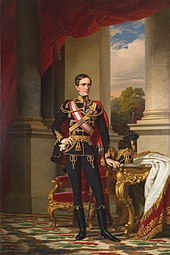Neo-absolutism
With neo-absolutism , among others, is called the governance of the Empire of Austria in the years 1851 to 1860 after the defeat of the March revolution that line the Enlightened despotism oriented of the 18th century and by the absence of a Constitution in the formal sense or Parliament was marked. The Kingdom of Prussia or France experienced a comparable period in the Second Empire . The term late absolutism is used for similar phenomena outside of Austria .
Empire of Austria
prehistory
In the course of the revolution of 1848/49 in the Austrian Empire , Emperor Ferdinand I first made some liberal concessions, such as the abolition of censorship , and had a draft of a constitutional monarchy ( Pillersdorf's constitution ) drawn up. Nevertheless, the revolution spread to all parts of the monarchy. In Lombardy , the Milan uprising led to the First Italian War of Independence , in Bohemia the Whitsun uprising in Prague broke out, and in March the revolution had spread to the Kingdom of Hungary from Pest .
Emperor Ferdinand I made further concessions that led to the liberation of the peasants and the end of subservience to heirs and the constitution of a parliament, known as the Reichstag . After the October Uprising in Vienna in 1848 , however, the conservative forces gained the upper hand, the Austrian delegates to the Frankfurt National Assembly were ordered back, and Ferdinand I had to abdicate in December in favor of his nephew Franz Joseph I. On March 7, 1849, the Austrian Reichstag , which had fled to Kremsier in Moravia, was dissolved by the new Emperor and Prince Felix zu Schwarzenberg and the revolution in Hungary was then suppressed with the help of Russian troops. The October constitution practically never came into force and was formally suspended on December 31, 1851 by the New Year's Eve patent. With that the emperor ruled absolutely again.
activities
Alexander von Bach was commissioned by the young Emperor Franz Joseph I to reorganize Austria in the conservative centralistic sense and from 1852 was not formally, but de facto the actual head of the government ("Ministry Bach"). A convened by Emperor Imperial Council had no meaning.
As a result, censorship was reintroduced, the universities reformed and, by the Concordat of 1855, the compulsory schools were returned to the care of the Catholic Church, from which Empress Maria Theresia had withdrawn them in 1774. On the other hand, the peasant liberation and land reform in the Austrian and Bohemian crown lands were not repealed . In addition, bourgeois capitalism was able to continue to prevail, and the first founding period came about . The Vienna city walls were torn down in 1858 to make way for the newly laid out Ringstrasse .
Conclusion and consequences
However, the Bach government came into distress with Sardinia-Piedmont as early as 1859 due to the Second Italian War of Independence and had to resign after the defeat of Solferino . With the October diploma of 1860 and the February patent of 1861, the emperor turned away from the neo-absolutist system of government for the first time. The phase of neo-absolutism was finally brought to an end after the German War of 1866 with the December constitution of 1867 and the Austro-Hungarian Compromise .
Historically, Austrian neo-absolutism should be viewed both as an attempt to eliminate liberal forces and bring power back into the hands of the emperor alone, and as a counter-model to the emerging nationalism of the Italian , Czech , Slovak and Hungarian populations in the multi-ethnic state. Likewise, it was directed against Greater German nationalism and thus prevented the national unity of Germany with the inclusion of the German-speaking Austrian crown lands ( Greater German solution ).
In art and architecture, neo-absolutism promoted historicism . One of the most ambitious projects was the Kaiserforum Wien. Numerous monuments and inscriptions were intended to illustrate the greatness of the Habsburg monarchy. A lack of political and economic successes (defeats in the Battle of Solferino and the Battle of Königgrätz , Gründerkrach on the Vienna Stock Exchange ) led to a disproportion between represented and actual power, which was reflected, for example, in the Viennese operetta .
literature
- Harm-Hinrich Brandt : The Austrian Neo-absolutism: State Finances and Politics 1848-1860. Vandenhoeck and Ruprecht, Göttingen 1978.
- Georg Christoph Berger Waldenegg: With united forces! On the relationship between rule practice and system consolidation in neo-absolutism using the example of the national loan from 1854. Böhlau, Vienna / Cologne / Weimar 2002, ISBN 3-205-77013-7 .
Web links
- Entry on neo-absolutism in the Austria Forum (in the AEIOU Austria Lexicon )

